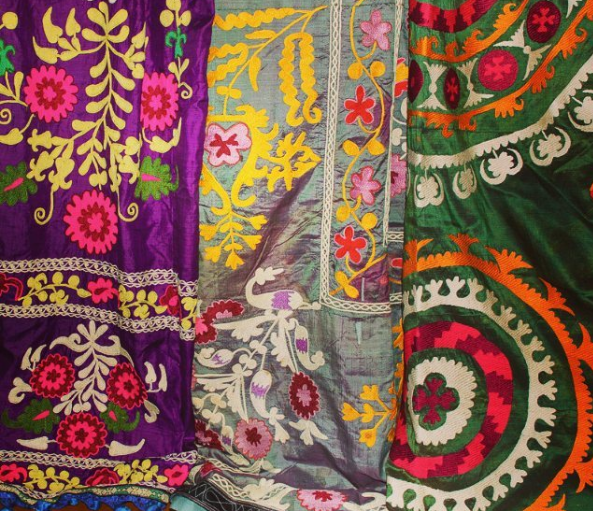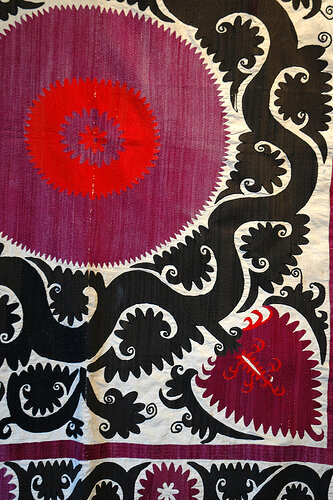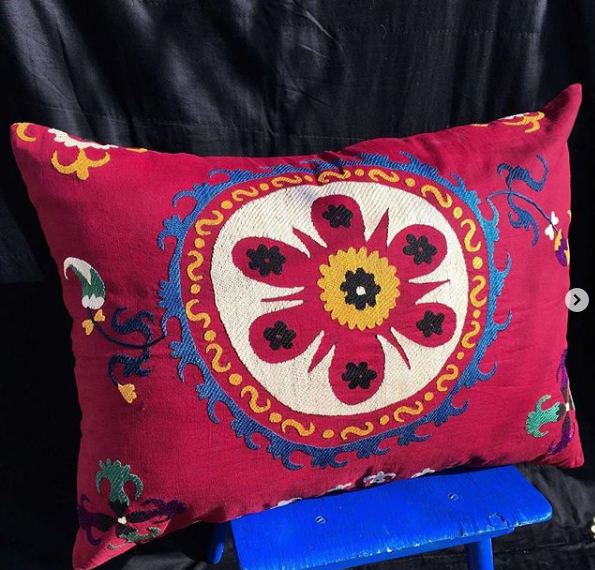
Categories
Suzani, an ethnic touch and color that cannot be missing in your decoration
Posted on July 18th, 2020 12:14 PM

This time we are going to talk about other of the great protagonists of our catalog : the suzani.
It is a type of cloth created by the nomadic tribes of Central Asia. Its name comes from the Persian word suzan , which means "needle". It is a cotton, linen or silk fabric embroidered with silk thread. Originally, the largest pieces were divided into strips that were then worked separately and joined together. Regarding design, floral motifs predominate almost exclusively. These reproduce all kinds of plant species such as the symbol of fertility and life. Colors have a glossy finish. Aubergines and browns stand out, standing out against usually red or natural tones. You will see it in the Suzani bags from the Kilim-Age catalog .
The embroidery of the suzani is very laborious. They are items of a very delicate conservation. In fact, it is quite difficult to find very old suzanis. As we say, they are hand-embroidered crafts that are more irregular than modern designs made in an industrial way. They offer a great chromatic richness due to the natural dyes used.
A colorful, colorful and usually rectangular hand-embroidered fabric

A suzani is a hand-embroidered cloth, typical of the nomadic tribes of Central Asia (Tajikistan, Uzbekistan, Kasajtan, India and nearby countries), whose name comes literally from the Tajik-Persian word "suzan", which means "needle-stitched".
The base is usually made of cotton, and occasionally linen or silk, with a uniform bottom. On this basis, elements are embroidered in silk or cotton thread with floral, geometric or abstract patterns.
The first thing that characterizes a suzani is its peculiar schematic design , where you can find strong colors that give these fabrics such a modern appearance. All of them share a similar design style and techniques: embroidery or appliques on plain fabrics, and the use of serene and bright colors that reflect geometric, vegetal and other natural elements. There are several styles of suzani depending on their area of origin: Bukhara, Istaravshan, Kulob, Lakai, Nurata, Samarkand, Shahritus, Tashkent ...
Normally the designs reproduce geometric figures (the sun or the moon), a wide variety of plant species (leaves, pomegranates, tulips, carnations or lilies) and even animal silhouettes (fish, birds). Flat colors with bright finishes are used to draw them, whose symbolism refers, among other things, to fertility and life.
So, depending on its origin , the Istaravshan suzani has large round flowers of many colors. The Samarkand suzani features ancient ornaments rich in content, mainly embroidered with silk threads. The Bukhara suzani is characterized by its unusual color scheme (mix of gray and blue, purple and violet, light yellow and orange threads), and the Kulob and Shahritus suzani largely includes both floral and geometric ornaments that they are distributed with great accuracy.

How are suzani made?
In all of them the base is usually mainly cotton, which is also embroidered with cotton or perhaps silk thread. But it can also be the other way around: silk fabrics with a cotton embroidery on top. These fabrics are often lightly dyed to produce a soft beige shade, the so-called "tea wash". And occasionally other colors are used for these fabrics that will form the background of the suzani.
The craftsman draws his designs by freehand on a flat background, which will serve as a guide for weaving with great care. If the fabric is very large, once drawn, it is usually cut into strips that will be joined after being embroidered by different artisan hands.

The embroidery techniques used are chain stitch, satin stitch and thread loop. In such a way that, by varying the direction of the needle, the thickness of the thread and the colors, the desired texture and depth effects are achieved.
Being pieces made by hand, embroidery can become truly laborious. And they have nothing to do with modern designs made by industrial machines. In fact, due to its artisan and to some extent domestic character, the Suzani are normally irregular both in the cut and in its finish.
For all these reasons, maintenance and cleaning are delicate tasks, and therefore it is not easy to find pieces that are truly old. The earliest Suzani preserved in museums and private collections are from the late 18th and early 19th centuries, but they were probably in use long before that time.
When evaluating them , four important factors count: laboriousness of the embroidery, age of the piece, size and state of conservation. In addition to the aesthetic value and its uniqueness, which in a way already enter into the subjective.
Being created of many dimensions, the usual thing is that they are one and a half meters wide, but they can be small enough to cover a cushion. As we indicated before, generally the largest pieces were divided into strips that, working separately, were later joined to cover larger surfaces. They could even reach 3 x 3 meters. Precisely because of these dimensions, sometimes the drawing of the different pieces did not fit perfectly after joining them.
For what purposes were the Suzani created? The colors of life

Following ancient techniques, in many tribes these valuable pieces were created to form part of the bride's dowry and began to be made even from the birth of a daughter for her trousseau. Directly by the mother, or the women of the family participating, dividing the work among them. The time it took to make one the traditional way, entirely by hand, could reach eighteen months.
Always conceived as ornaments , they could well adorn the hall for the wedding, the altar, a canopy to shelter the bride and groom at some stage of the ceremony, or to cover the wedding bed. The origin of the word baldaquino comes from the Italian baldacchino, which corresponds to the way in which the Persian city of Bagdag was known in the Middle Ages.

The suzani offer a great chromatic richness due to the natural dyes that are used to make them. At least it was like that before, since today, still embroidered by hand, synthetic products are already used.
In fact, the difference between the more traditional Suzani made with materials dyed with natural dyes and those made with synthetic materials dyed chemically is significant. In some pieces of synthetic dyeing the colors are not stable and therefore cannot be cheerfully cleaned ...
Among the colors, we can find for example with motifs in aubergine and brown colors, on backgrounds that may well be natural or even red. When commenting on the origins according to cities, we already indicated that certain combinations and color schemes are typical of some of them.
Sometimes each color has its own meaning. In the case of oranges and yellows, their stitches represent knowledge, blues suggest the sky, greens that embody youth, and reds (of course) mean fire. But in the end, the symbols and their meanings depended on the tribe, the family, religion and the craftsman himself.







 Categories
Categories 



